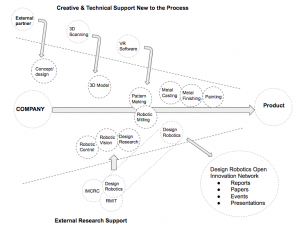REVIEW | OPEN INNOVATION
Open Innovation (OI) describes distributed and collaborative practices that amplify innovation. At its
core, the practice is about opening up organisational boundaries to allow the exchange of knowledge with
others.

Design Robotics Open Innovation Pathway
There are two important kinds of open innovation: in-bound and out-bound. In-bound innovation is
the process of incorporating external knowledge, while out-bound innovation describes the process
of taking internal knowledge to the wider marketplace for others to develop and enhance.
OI approaches bring together diverse partners such as research institutes, industry and government to
increase the speed and reduce the risks associated with innovating, particularly for smaller organisations.
By providing SMEs access to advanced technologies and expertise, such collaborative arrangements facilitate
the development of products and technologies with organisations often without the resources to manage such
development on their own.
These collaborative arrangements have many labels – hubs, networks, clusters, accelerators, and incubators,
for example. They can emerge organically, or be purposefully created, with national, regional, sectoral, or
technological agendas. Silicon Valley is an iconic example of an innovation cluster. Ecosystems are
another type of collaborative arrangement usually set up to encourage a large number of diverse
organisations to think beyond their traditional supply chains. These large networks are often coordinated by
a central platform leader or hub firm that, among other responsibilities, is tasked with managing direction
and opportunities, and overseeing agreements and aspects of IP governance.
Opening up to outbound use of IP is one of the main challenges for organisations in adopting OI practices.
Those most successful have managed opportunities in both inbound and outbound innovation – diversifying
their product pipeline while developing absorptive capacity to leverage the resources of others within the
network. Opening up knowledge accelerates research and development processes. It provides ways for
organisations to address new and emerging challenges and creates opportunities for innovation not previously
considered possible.
The Future of Manufacturing
With support from the Innovative Manufacturing Cooperative Research Centre (IMCRC), Design Robotics is collaborating to present a range of new
fabrication and vision systems solutions. The goal is simple – to design for human intelligence and optimize
the relationship between people and machines.
Pushing the limits of industrial robotics is a move to empower people. Navigating the increasing complexity
of manufacturing inevitably supports human experience and enhances skills acquisition. At its heart, this
approach celebrates the best of what robots and machines can achieve – problem-solving, and the best of what
humans can do – social intelligence and contextual understanding.
Support Opportunities (Australia)
- Advanced Robotics for Manufacturing (Qld) – armhub.com.au/
- Australian Research Council – arc.gov.au/grants
- Innovative Manufacturing CRC – imcrc.org/
- Advanced Manufacturing Growth Centre amgc.org.au/our-purpose/about-amgc/
Resources
- Openinnovation.net – Wealth of up-to-date press and articles. Site hosted by Henry Chesbrough, Executive Director of the Center for Open Innovation at the Haas School of Business, UC Berkeley Gartner.com/Develop-an-open-innovation-framework
- Samsung.com/open-innovation
- Airbus.com/open-innovation
- Manufacturingusa.com/institutes
- A manufacturing network in California cmtc.com/cmn